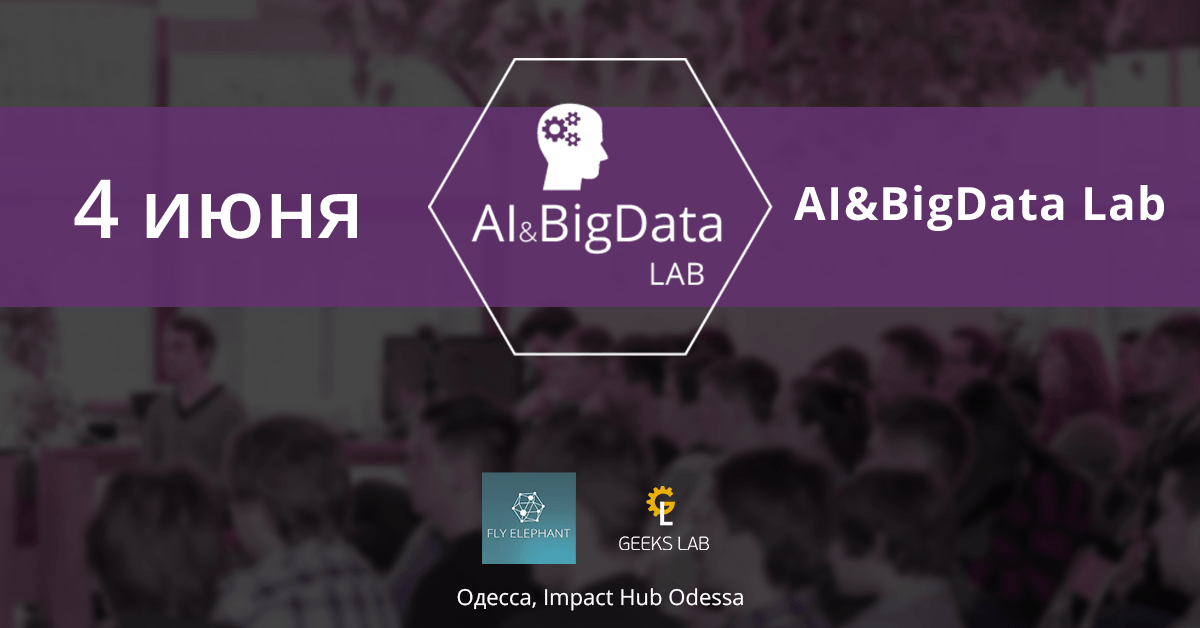We invite you to the conference on artificial intelligence and big data AI & BigData Lab June 4

On June 4, in Odessa , our team FlyElephant together with GeeksLab will hold the third annual technical conference on artificial intelligence and big data - AI & BigData Lab .
At the conference, developers will discuss the implementation and application of various algorithms, tools and new technologies for working with big data and artificial intelligence. The projects implemented will be presented, the functionality and principles of their work will be described.
')
The program of the AI & BigData Lab conference is already partially formed. Among the accepted reports include:
- How we taught to think digital. (Diana Limanskaya, Coordinator of the Analytics Department at VertaMedia)
When you go to the site to watch your favorite movie or TV series, you wait a few seconds before the ads are shown to you. In these few seconds before the display of advertising, hundreds of complex processes occur. I want to tell how we created a self-learning system for a digital marketing platform based on mathematical methods, what stages we went through in its development and what problems we encountered. - Translation from “bad” English to “good”. (Anatoly Vostryakov, a researcher at Grammarly)
At the beginning I want to give a little historical insight into the methods of automatic error correction in tests. In the main part of the report, I would like to highlight the latest methods of error correction using, what is now called neural machine translation. That is, we translate the English text into English, but with corrected errors on the output. Unfortunately, I am limited to concrete examples from the practice of Grammerli, so the report will be in the form of a review of algorithms that are already there or appear at the time of the report. - Efficiently calculate k averages for a distributed big data stream. (Artem Barger, Research Engineer at IBM, Israel)
In the report, I will provide a deterministic algorithm that allows you to efficiently calculate k average means (k-means) in a continuous data stream in real time. The sublinear algorithm uses only logn * k ^ O (1) memory, also easily adapts to distributed computing systems, which allows to reduce the computation time by directly proportional available computing powers. At the end, empirical results for popular data sets will be presented. - #DataForGood - how to change the world for the better through data analysis. (Maxim Tereshchenko, Product Owner at Zoomdata)
The use of Big Data to optimize and improve the efficiency of decision making in business is already mentioned. Almost every large corporation has in its arsenal a Big Data platform. But within the framework of the report I would like to move away from business and consider the topic of using AI and Big Data for social projects. Hundreds and thousands of analysts, Data Scientists, Big Data engineers unite and implement projects that change the lives of ordinary people around the world and, especially, help people in poorly developed countries. Here we are talking about a very different level of motivation and teamwork. As part of the report, I would like to discuss what drives these people, what real projects with which technologies were implemented and how they changed people's lives. - Methodology Data Science projects. (Sergey Shelpuk, Head of Data Science at VITech)
Data analysis projects are a challenge not only for engineers, but also for managers. The report will be devoted to the peculiarities of such projects as compared with the usual development, roles in the team and building interaction with the customer in the face of uncertainty in R & D. - Learning deep, very deep and recurrent networks. (Artem Chernodub, associate professor at IPMMS NASU)
The report provides an overview of new approaches to learning deep and recurrent neural networks. We discuss orthogonal initialization of weights for convolutional and recurrent neural networks and its influence on the problem of vanishing gradient effect, normalization of mini-packets (batch normalization), and residual learning. - MOLAP: New frontiers of the possible. (Konstantin Gerasimenko, CEO at Easy MOLAP, Germany)
The story of what MOLAP. Comparison with traditional approaches. Advantages and disadvantages. - Spike and bionic neural networks: problems and perspectives. (Dmitry Novitsky, Senior Researcher, Associate Professor at the Institute of Cybernetics, NASU)
In the world of machine learning, for many years, feed-forward neural networks have dominated, which have almost nothing in common with neurons and networks of our brain. In this report, we will introduce bionic (biologically plausible) neural networks. In most of them, neurons emit and receive impulses (spikes). What are the problems and difficulties of learning such networks? In which traditionally unsolvable (or poorly solvable) problems can they be effective, how effective are the brains of humans and animals in them? How can such networks be implemented in hardware, and what is neuromorphic computing? - Here are the questions that this presentation is devoted to.
Registration and all details on the conference website . For readers of our blog, there is a 15% discount code: FlyElephantHabrahabr.
Source: https://habr.com/ru/post/282558/
All Articles